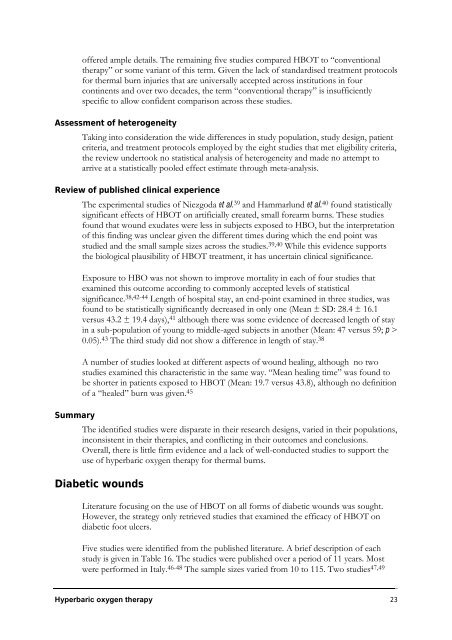Hyperbaric Oxygen Therapy - Hyperbaric Chamber Information ...
Hyperbaric Oxygen Therapy - Hyperbaric Chamber Information ...
Hyperbaric Oxygen Therapy - Hyperbaric Chamber Information ...
Create successful ePaper yourself
Turn your PDF publications into a flip-book with our unique Google optimized e-Paper software.
offered ample details. The remaining five studies compared HBOT to “conventional<br />
therapy” or some variant of this term. Given the lack of standardised treatment protocols<br />
for thermal burn injuries that are universally accepted across institutions in four<br />
continents and over two decades, the term “conventional therapy” is insufficiently<br />
specific to allow confident comparison across these studies.<br />
Assessment of heterogeneity<br />
Taking into consideration the wide differences in study population, study design, patient<br />
criteria, and treatment protocols employed by the eight studies that met eligibility criteria,<br />
the review undertook no statistical analysis of heterogeneity and made no attempt to<br />
arrive at a statistically pooled effect estimate through meta-analysis.<br />
Review of published clinical experience<br />
The experimental studies of Niezgoda et al. 39 and Hammarlund et al. 40 found statistically<br />
significant effects of HBOT on artificially created, small forearm burns. These studies<br />
found that wound exudates were less in subjects exposed to HBO, but the interpretation<br />
of this finding was unclear given the different times during which the end point was<br />
studied and the small sample sizes across the studies. 39,40 While this evidence supports<br />
the biological plausibility of HBOT treatment, it has uncertain clinical significance.<br />
Exposure to HBO was not shown to improve mortality in each of four studies that<br />
examined this outcome according to commonly accepted levels of statistical<br />
significance. 38,42-44 Length of hospital stay, an end-point examined in three studies, was<br />
found to be statistically significantly decreased in only one (Mean ± SD: 28.4 ± 16.1<br />
versus 43.2 ± 19.4 days), 41 although there was some evidence of decreased length of stay<br />
in a sub-population of young to middle-aged subjects in another (Mean: 47 versus 59; p ><br />
0.05). 43 The third study did not show a difference in length of stay. 38<br />
A number of studies looked at different aspects of wound healing, although no two<br />
studies examined this characteristic in the same way. “Mean healing time” was found to<br />
be shorter in patients exposed to HBOT (Mean: 19.7 versus 43.8), although no definition<br />
of a “healed” burn was given. 45<br />
Summary<br />
The identified studies were disparate in their research designs, varied in their populations,<br />
inconsistent in their therapies, and conflicting in their outcomes and conclusions.<br />
Overall, there is little firm evidence and a lack of well-conducted studies to support the<br />
use of hyperbaric oxygen therapy for thermal burns.<br />
Diabetic wounds<br />
Literature focusing on the use of HBOT on all forms of diabetic wounds was sought.<br />
However, the strategy only retrieved studies that examined the efficacy of HBOT on<br />
diabetic foot ulcers.<br />
Five studies were identified from the published literature. A brief description of each<br />
study is given in Table 16. The studies were published over a period of 11 years. Most<br />
were performed in Italy. 46-48 The sample sizes varied from 10 to 115. Two studies 47,49<br />
<strong>Hyperbaric</strong> oxygen therapy 23



